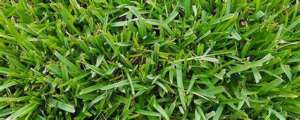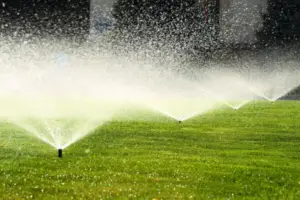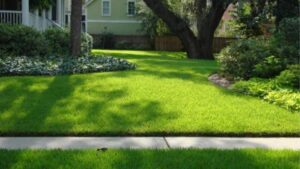Table of Contents
 Welcome to our comprehensive guide on making St. Augustine grass thicker! If you’ve ever dreamed of having a lush, green lawn that feels like a soft carpet under your feet, you’ve come to the right place. St. Augustine grass is renowned for its vibrant emerald hue and resilience, making it a popular choice for lawns in various climates.
Welcome to our comprehensive guide on making St. Augustine grass thicker! If you’ve ever dreamed of having a lush, green lawn that feels like a soft carpet under your feet, you’ve come to the right place. St. Augustine grass is renowned for its vibrant emerald hue and resilience, making it a popular choice for lawns in various climates.
A thick and healthy lawn enhances the aesthetic appeal of your property and offers numerous practical benefits. A dense St. Augustine grass lawn is valuable, from preventing soil erosion to filtering pollutants and providing a safe play area for children and pets.
This blog post will take you on a step-by-step journey to achieve your desired luxurious thickness. From understanding the unique characteristics of St. Augustine grass to implementing the right soil preparation, mowing, watering, and fertilization techniques, we’ll cover everything you need to know. Let’s embark on this green adventure and transform your lawn into a breathtaking oasis of beauty and tranquility.
If your St. Augustin grass is dead, you must be educated to revive your grass.
You may also see our guide about how to plant grass seed on hard dirt and learn more.
How To Make St Augustine Grass Thicker? – Easy Methods

St. Augustine grass is a good choice for your yard, but keeping it looking its best can be challenging. This problem is worsened by other plants in your garden that have been there for years and have roots that are harder to control than those of new plants. You can make your St. Augustine grass grow thicker and fuller by aerating the soil, fertilizing it, and controlling weeds.
Methods To Grow St. Augustine Grass
Here are some easy methods for making St. Augustine grass thicker:
Soil Preparation
To grow St. Augustine grass successfully, start with proper soil preparation. Conduct a soil test to determine pH and nutrient levels. Using lime or sulfur, adjust the pH to the optimal range (around 6.0 to 6.5). Ensure the soil is free of debris and rocks to create a smooth planting surface for your grass to thrive.
Choosing the Right Variety
The appropriate St. Augustine grass variety is crucial for successful growth. Consider your climate and region when choosing the variety. Popular options include Floratam, Palmetto, Raleigh, and Bitterblue. Each variety has unique characteristics, so choose the one best suited to your lawn’s needs.
Sodding or Seeding
St. Augustine grass is typically established through sodding or plugs, but some varieties can be grown from seeds. Consider sodding with high-quality grass sod from a reputable supplier for faster results. Alternatively, if you opt for seeding, follow the seed manufacturer’s instructions for proper techniques and timing.
Watering Strategies
Proper watering is vital for establishing St. Augustine grass. Regularly water the grass after planting sod or plugs to moisten the soil. Once the grass is established, switch to deep and infrequent watering to encourage strong root growth.
Mowing Practices
When mowing St. Augustine grass, set the mower to the recommended height, usually around 3.5 to 4 inches. Avoid cutting the grass too short (scalping), and never remove more than one-third of the grass blade in a single mowing. Mow regularly to keep the lawn at the desired height and maintain a neat appearance.
Visit Also: When Does Grass Stop Growing?
Fertilization Tips
Fertilize your St. Augustine grass with a balanced fertilizer with a higher nitrogen content. For example, a 16-4-8 fertilizer will promote healthy growth. Follow a fertilization schedule based on your grass’s specific needs and your area’s climate to ensure optimal results.
Weed, Pest, and Disease Management
Keep a close eye on your lawn for any signs of weeds, pests, or diseases. Regular maintenance and proper care will help prevent these issues. Apply pre-emergent herbicides in early spring to prevent weed seeds from germinating. If problems arise, address them promptly to prevent further damage.
Aeration for Healthy Roots
To improve soil drainage and promote root growth, aerate your St. Augustine grass lawn annually. Aeration creates small holes in the soil, allowing water, air, and nutrients to reach the grassroots more effectively.
Shade Tolerance Considerations
St. Augustine grass prefers full sun, but some varieties have better shade tolerance than others. If your lawn has areas with partial shade, choose shade-tolerant St. Augustine grass varieties to ensure proper growth in these conditions.
Traffic Control and Maintenance
Limit heavy foot traffic on the lawn, especially during periods of stress or dormancy. Regularly maintain your lawn by following the appropriate care practices to keep it healthy and attractive throughout the year.
By following these methods and incorporating them into your lawn care routine, you’ll create an inviting and vibrant St. Augustine grass lawn that enhances the beauty of your outdoor space.

Ways To Make Grass Spread Fast And Grow Well
When you have a lawn that needs more green, it’s time to add more grass seed. Here are some ways to make it grow fast and well.
- Water it well, especially in the spring and fall.
- Add nitrogen fertilizer to your lawn as needed (grass grows best in a balanced pH of 6.5-7.5).
- Mow at 1/3 inches or less (low mowing will help keep your lawn healthy).
- If you have an area that gets very dry during the summer, consider watering it with drip irrigation or sprinkler irrigation to avoid water stress.
Mistakes In Growing St Augustine Grass
The steps to growing St Augustine grass are simple. They are quick and easy too! A little bit of sun, a little bit of water, and they’re done. If you grow St Augustine grass on your lawn, you must ensure the grass is cut correctly and mold it regularly to keep it looking good. However, some of the worst mistakes people make when they’re trying to grow St. Augustine grass are:
- The first mistake people make when they first try to grow St. Augustine grass does not know the correct type of soil. While most people think good garden soil will be perfect, this is not always true.
- The best soil for growing St. Augustine grass has been amended with sand or pumice and composted. This will help keep the plant’s roots healthy and strong while providing nutrients for it to use when it needs them.
- Another mistake people make when they try to grow St. Augustine grass is choosing an inappropriate time of year to plant it. While some people may think springtime is an ideal time for planting, others may prefer autumn as a better option due to cooler temperatures and more reliable weather conditions.
- Another mistake people make when trying to grow St. Augustine grass is planting it where other plants are growing in the same area. While there may be benefits from having multiple plants growing together in one place, such as better pollination between them or lower maintenance costs due to shared resources like water.
Which Is The Best Fertilization For St. Augustin Grass?
To achieve the best fertilization results and promote healthy growth in St. Augustine grass, it’s essential to understand the specific nutrient requirements and the proper application timing. Here’s an explanation of the best fertilization practices for St. Augustine grass:
1. Balanced Fertilizer with Higher Nitrogen (N) Content: St. Augustine grass thrives when provided with a balanced fertilizer with a higher nitrogen percentage (N). Nitrogen is crucial for promoting vigorous leaf and shoot growth, particularly for St. Augustine grass, known for its lush appearance. Look for a fertilizer with an N-P-K (nitrogen-phosphorus-potassium) ratio, such as 16-4-8 or 15-0-15, with the first number (nitrogen) significantly higher than the others.
2. Slow-Release Formulation: Opt for a slow-release fertilizer to provide a steady supply of nutrients over time. Slow-release fertilizers gradually release nutrients into the soil, reducing the risk of leaching and ensuring that the grass receives a continuous supply of essential nutrients. This promotes steady growth and minimizes the risk of nutrient deficiencies or excesses.
3. Seasonal Fertilization Schedule: St. Augustine grass has different yearly nutrient requirements. Typically, it benefits from fertilization in late spring, early summer, and early fall. Avoid fertilizing during the winter months when the grass is dormant. The specific timing may vary depending on your region and climate. Follow local guidelines or consult a lawn care professional to determine the best schedule for your area.
4. Proper Application Rates: Apply the fertilizer at the recommended rates to avoid over-fertilization, which can lead to environmental issues and excessive growth. Follow the instructions on the fertilizer packaging or seek guidance from a lawn care expert to ensure accurate application rates.
5. Watering after Fertilization: After applying the fertilizer, water the lawn thoroughly. This helps to activate the nutrients and deliver them to the root zone of the St. Augustine grass. Adequate watering after fertilization ensures that the nutrients are readily available for uptake by the grass.
6. Avoid Fertilizing During Stressful Conditions: Refrain from fertilizing St. Augustine grass during drought, extreme heat, or other stressful conditions. Fertilizing during stress can harm the grass and lead to nutrient leaching.
7. Soil Testing and Adjustments: Periodically conduct soil tests to assess the nutrient levels in your lawn. Based on the soil test results, adjust your fertilization plan accordingly. Over time, this helps maintain a healthy nutrient balance and prevents imbalances or deficiencies.
Does St. Augustin Grass Like Shade Or Sun?

St. Augustine grass prefers and thrives in areas with ample sunlight. It is considered a warm-season grass and is well-suited to regions with a predominantly warm climate and plenty of sunlight. St. Augustine grass generally requires at least 6 to 8 hours of direct sunlight daily to maintain its health and vibrant green color.
Sunlight Requirements:
- St. Augustine grass performs best in full sun conditions, receiving maximum sunlight throughout the day.
- Full sun exposure ensures robust photosynthesis, essential for the grass to produce and store energy for growth and repair.
Shade Tolerance:
- While St. Augustine grass prefers full sun, it has some shade tolerance, making it more adaptable than other warm-season grasses like Bermuda grass.
- Certain St. Augustine grass varieties, such as Palmetto and Seville, have better shade tolerance than others, like Floratam, which prefers full sun.
- St. Augustine grass can handle partial shade or dappled sunlight for a few hours daily. However, prolonged periods of heavy shade can stress the grass, leading to thinner growth and potential pest or disease issues.
Considerations for Shade:
- If you have areas with shade in your lawn, choosing a shade-tolerant St. Augustine grass variety is advisable.
- Ensure proper tree pruning and trimming to allow more sunlight to reach the grass.
- Avoid heavy foot traffic in shaded areas, as St. Augustine grass in the shade is generally weaker and more susceptible to damage.
Learn more about: Will baking soda kill grass?
FAQ
How do you keep your grass thick?
Nitrogen, phosphorus, and potassium. The nitrogen content is high enough to keep the grass healthy and strong but not so high that it will cause harm to your lawn.
Can you fix the brown and yellow patches of st Augustine grass?
Adding more grass seed can fix the yellow patches and brown on your st Augustine grass.
Which soil is the best for grass?
Well-drained soil is the best for St. Augustine grass.
Conclusion
By reading this article, you can grow St Augustine grass thicker and more beautifully. You can make the St. Augustine grass thicker using the proper techniques and organic substances or microorganisms. It is very easy to grow, pest-free, and disease-free. When you have a lawn that needs more green, it’s time to add more grass seed. Here are some ways to make it grow fast and well.

